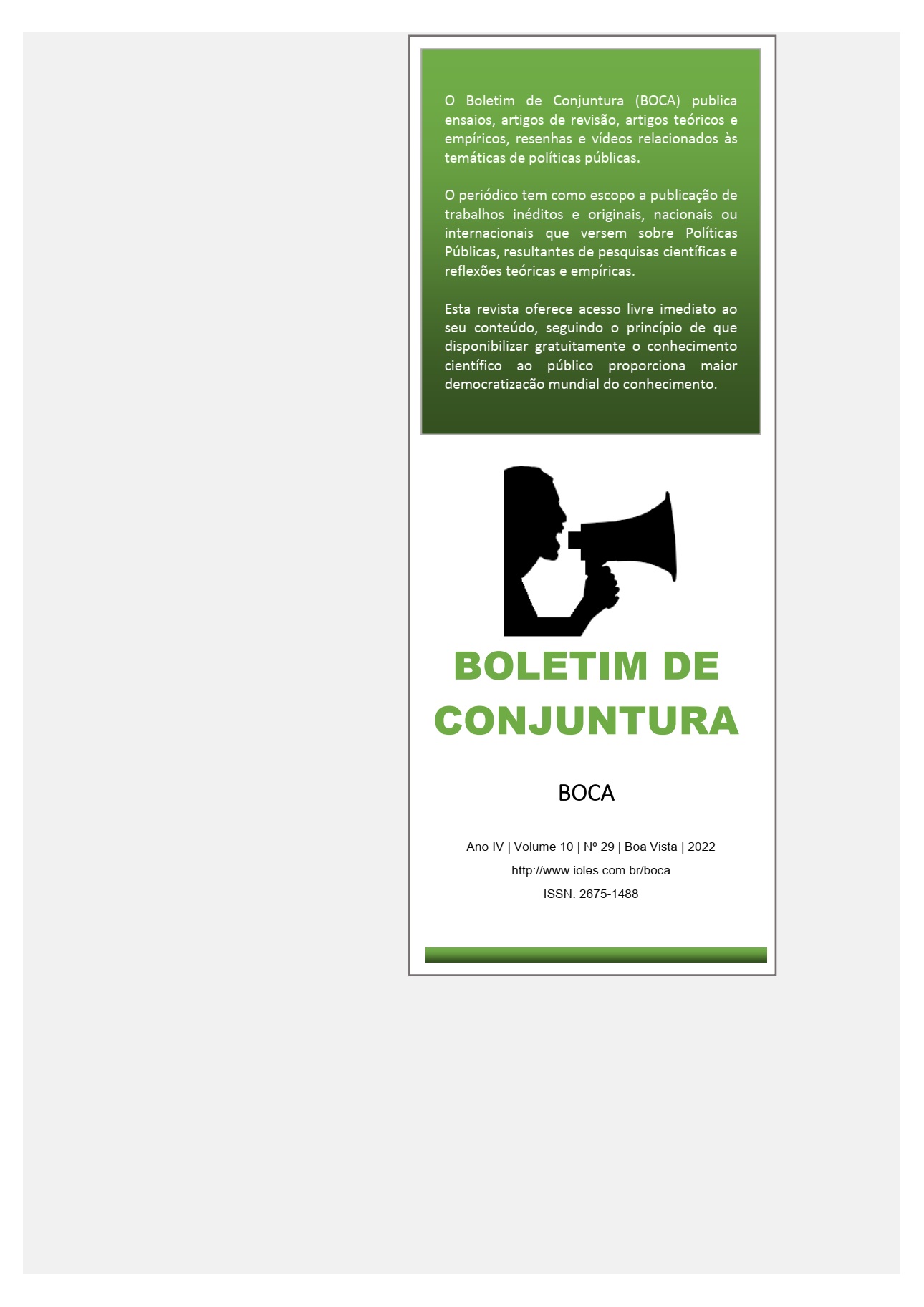CROSS-CULTURAL ADAPTATION AND EVIDENCE OF THE VALIDITY OF THE MEASURE OF FAT BIAS SCALE FOR USE IN BRAZIL
Main Article Content
Abstract
The Measure of Fat Bias is a scale developed to assess fat bias. The purpose of the study was to realize the cross-cultural adaptation of this scale and identify its psychometric properties for the Brazilian population in an exploratory level. METHODS: All cross-cultural adaptation procedures followed the recommendations by Borsa et al. (2012). The final version of the cross-culturally adapted scale was administered to a sample of 394 adult subjects from the general population of residents in Brazil, most of whom were female (91.11%; N = 359) and the average age of the sample was 43.22 years (SD = 13.87). To identify the psychometric properties, Exploratory Factor Analysis (EFA) was performed in the FACTOR software. The EFA was implemented using the Robust Diagonally Weighted Least Squares (RDWLS) estimation technique. The decision on the number of factors to be retained was taken using the Optimal Implementation of Parallel Analysis technique. The rotation used was Robust Promin in all analyzes with more than one factor. To analyze the internal consistency of each dimension, the Composite Reliability coefficient was used. RESULTS: After the cross-cultural adaptation, the committee of judges considered that the Portuguese version of the scale presented semantic, idiomatic, cultural and conceptual equivalence. The EFA presented a structure of 3 dimensions, unlike the original version, which presented 4. However, these dimensions were grouped in a semantically and theoretically coherent way, explaining 12.42% of the total variance. Internal consistency values were strong: Composite Reliability showed a coefficient of 0.8 for Factor 1 - Adverse Judgment; coefficient of 0.8 for Factor 2 - Attraction and Proximity and coefficient of 0.9 for Factor 3 - Equal Rights, while Cronbach's α showed a coefficient of 0.90. The adjustment indices for the exploratory analysis of the instrument were compatible s (χ2 = 1067.672, gl = 133; p < 0.001; CFI = 0.927; TLI = 0.896). A of RMSEA = 0.134, which was considered poor (above 0.100). CONCLUSIONS: The cross-cultural adaptation and the exploratory psychometric qualities of the Measure of Fat Bias scale were satisfactory.
Article Details

This work is licensed under a Creative Commons Attribution 4.0 International License.
Copyright (c). Conjuncture Bulletin (BOCA)
This work is licensed under a Creative Commons Attribution 4.0 International License.
References
ALLPORT, G. W. The nature of prejudice. London: Addison-Wesley, 1954.
AMBIEL, R. A. M. et al. “E viveram felizes para sempre: a longa (e necessária) relação entre psicologia e estatística”. In: AMBIEL, R. A. M. et al. (eds.). Avaliação Psicológica: guia de consulta para estudantes e profissionais de psicologia. Perdizes: Editora Casa do Psicólogo, 2011.
ASPAROUHOV, T.; MUTHÉN, B. Simple second order chi-square correction. Los Angeles: Muthén and Muthén, 2010.
BORSA, J. C. et al. “Adaptação e validação de instrumentos psicológicos entre culturas: algumas considerações”. Revista Paidéia, vol. 22, n. 53, 2012.
BRASIL. Resolução n. 466, de 12 de dezembro de 2012. Brasília: Ministério da Saúde, 2012. Disponível em: . Acesso em: 02/01/2022.
BRASIL. Resolução n. 510, de 07 de abril de 2016. Brasília: Ministério da Saúde, 2016. Disponível em: . Acesso em: 02/01/2022.
BROWN, T. Confirmatory Factor Analysis for Applied Research. New York: Guilford Press, 2015.
DAMÁSIO, B. “Análise Fatorial e Modelagem por Equações Estruturais”. Psicometria Online Academy. [2021]. Disponível em: . Acesso em: 02/04/2022.
DAMÁSIO, B. “Análise Fatorial e Modelagem por Equações Estruturais”. Psicometria Online Academy. [2021]. Disponível em: . Acesso em: 02/04/2022.
DAMÁSIO, B. “Escrita Científica de Alto Impacto - Descrição dos instrumentos”. Psicometria Online Academy. [2021]. Disponível em: . Acesso em: 02/04/2022.
FERRANDO, P. J.; LORENZO-SEVA, U. “Assessing the quality and appropriateness of factor solutions and factor score estimates in exploratory item factor analysis”. Educational and Psychological Measurement, vol. 78, n. 5, 2018.
FITTERMAN‐HARRIS, H. F.; VANDER WAL, J. S. “Weight bias reduction among first‐year medical students: A quasi‐randomized, controlled trial”. Clinical Obesity, vol. 11, n. 6, 2021.
GOODE, E. “The stigma of obesity”. In: CONYERS, A.; CALHOUN, T. C. Deviance Today. Oxfordshire: Routledge, 2020.
GORSUCH, R. L. Factor analysis. Lawrence: Erlbaum Associates Inc, 1983.
HAIR, H. J. “Exploratory factor analysis: A review of research from 1993 to 2003”. Journal of Managment, vol. 14, n. 4, 2005.
HUTCHESON, G.; SOFRONIOU, N. The Multivariate Social Scientist: Introductory Statistics Using Generalized Linear Models. London: Sage Publications, 1999.
LATNER, J. D. et al. “Weighing obesity stigma: The relative strength of different forms of bias”. International Journal of Obesity, vol. 32, n. 7, 2008.
LORENZO-SEVA, U.; FERRANDO, P. J. “Robust Promin: a method for diagonally weighted factor rotation”. Liberabit, vol. 25, n. 1, 2019.
LORENZO-SEVA, U.; TIMMERMAN, M. E.; KIERS, H. A. “The Hull method for selecting the number of common factors”. Multivariate Behavioral Research, vol. 46, n. 2, 2011.
MENEZES, T. S. B. et al. “Crenças e estereótipos sobre o excesso de peso”. Boletim de Conjuntura (BOCA), vol. 7, n. 20, 2021.
MENEZES, T. S. B. Modelo explicativo do preconceito contra pessoas gordas (Tese de Doutorado em Psicologia Social). João Pessoa: UFPB, 2022.
MARDIA, K. V. “Measures of multivariate skewnees and kurtosis with applications”. Biometrika, vol. 57, n. 3, 1970.
PAIM, M. B.; KOVALESKI, D. F. “Análise das diretrizes brasileiras de obesidade: patologização do corpo gordo, abordagem focada na perda de peso e gordofobia”. Saúde e Sociedade, vol. 29, n. 1, 2020.
TABACHNICK, B. G.; FIDELL, L. S.; ULLMAN, J. B. Using multivariate statistics. Sydney: Pearson, 2007.
TIMMERMAN, M. E.; LORENZO-SEVA, U. “Dimensionality Assessment of Ordered Polytomous Items with Parallel Analysis”. Psychological Methods, vol. 16, n. 2, 2011.
WU, A. D.; ZUMBO, B. D. “Using Pratt’s Importance Measures in Confirmatory Factor Analyses”. Journal of Modern Applied Statistical Methods, vol. 16, n. 2, 2017.


